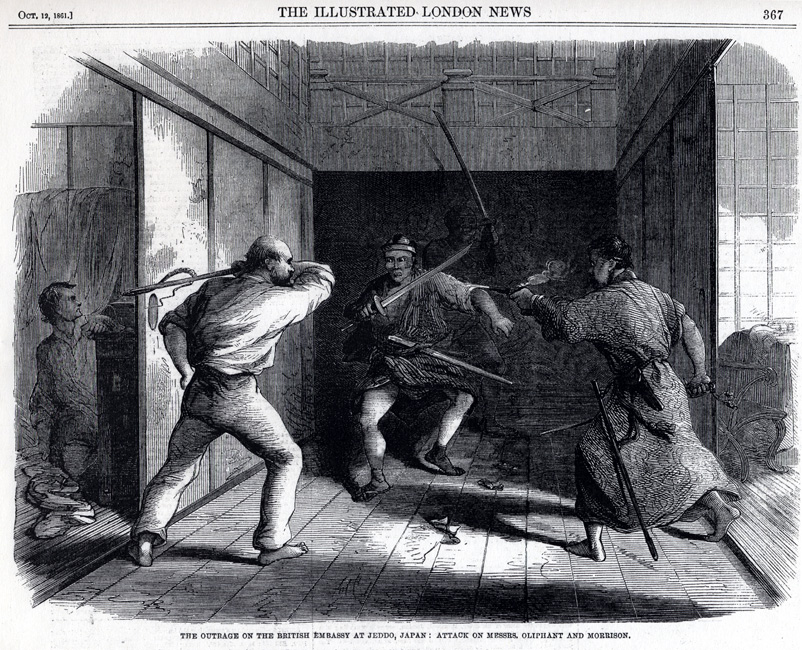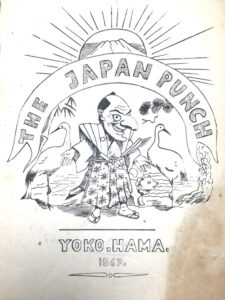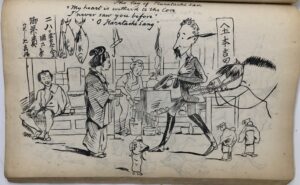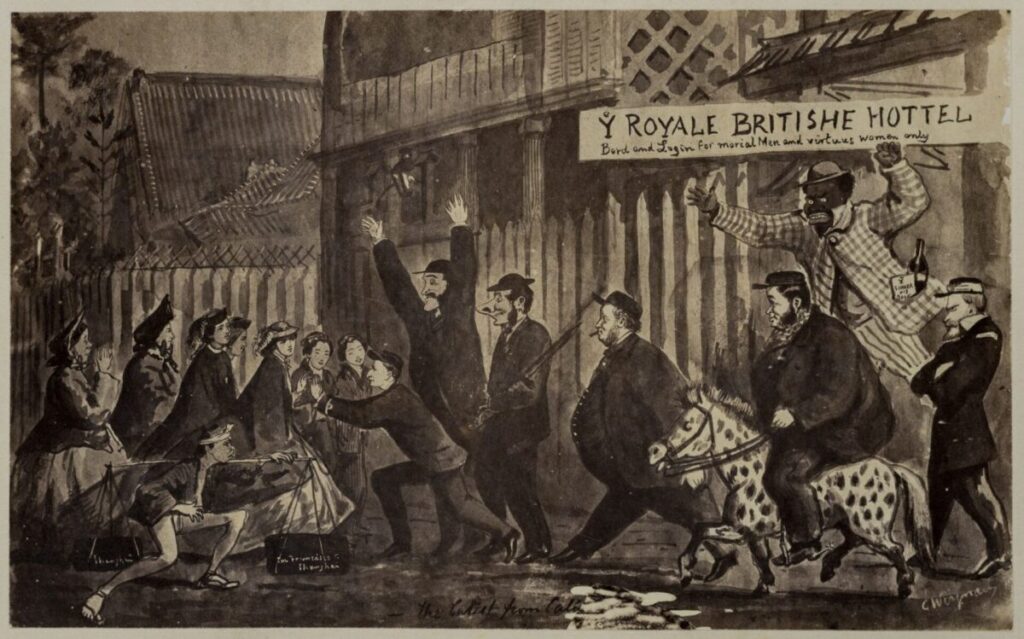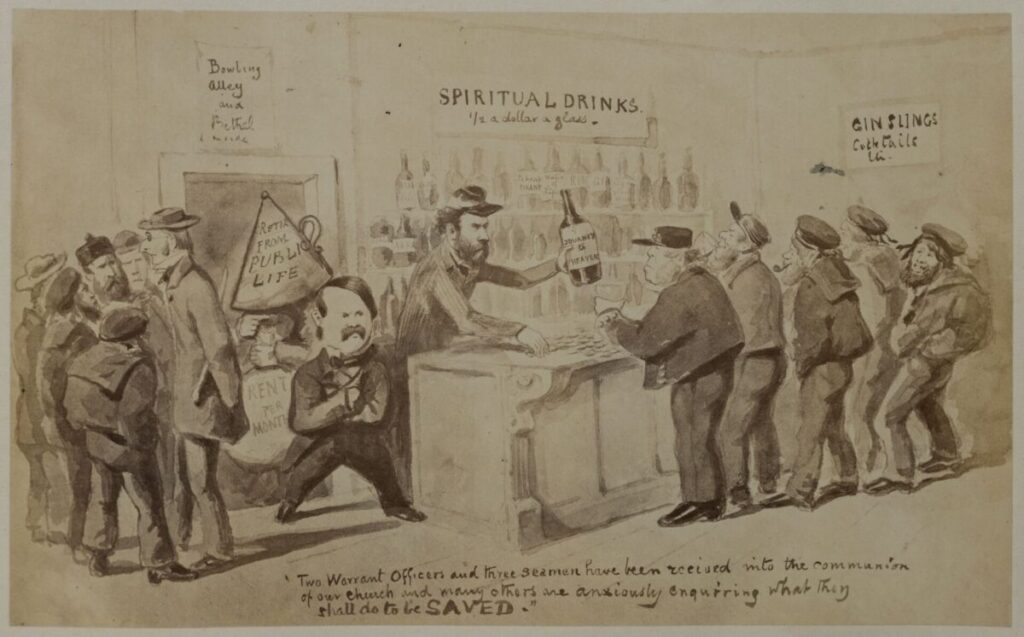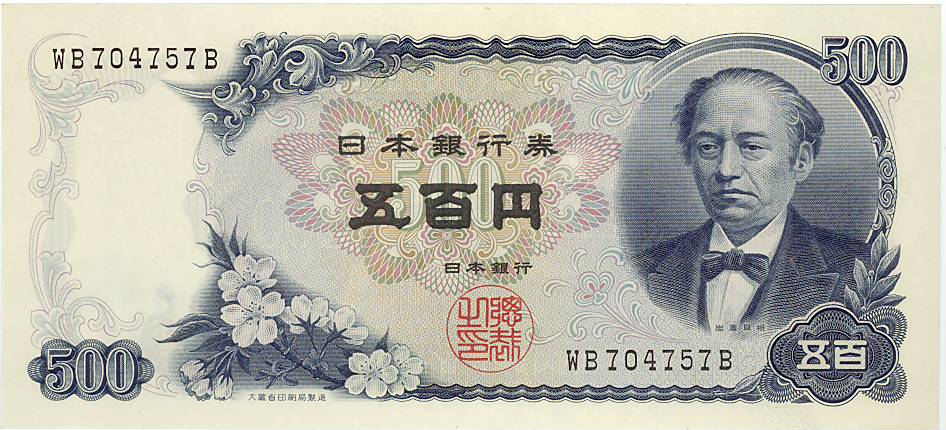Chapter 3 : Started importing whisky to Japan
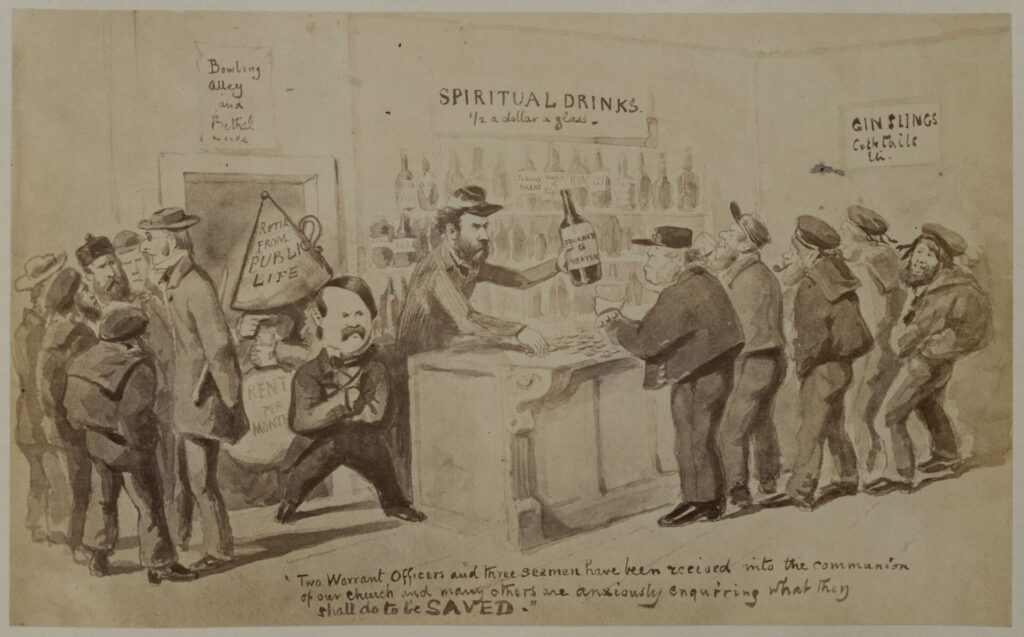
1. Japan’s first Western-style hotel
Four more years after Perry concluded the Treaty of Harmony between Japan and the United States with the Shogunate and opened the country.
In June 1858, U.S. Consul General Townsend Harris concluded the Nichibei-shuko-tsusho-zyoyaku (Treaty of Amity and Commerce between Japan and the U.S.) in order to begin full-scale trade with Japan.
At the same time, as a result of the treaty of amity and commerce with the Netherlands, Russia, the United Kingdom, and France, merchants from various countries came to Japan and all cultures from overseas flowed in.
The Treaty of Amity and Commerce providing settlements where foreigners live and places to do business.
As a result, various voices of dissatisfaction with the information and culture that are pouring in from overseas, the response of the shogunate to them, and voices worried about Japan in the future are born, The Sakuradamongai-no-hen (Sakuradamon Incident) in 1860,The change of The Tenchu gumi no hen (Tenchu-gumi Incident) in 1863 and the Ikuno-no-hen (Ikuno Incident),It was divided into the Abugun school including Ryoma Sakamoto such as the Satsuei-senso (Anglo-Satsuma War), and the Sonnojoi ( Revere the Emperor and expel the barbarians) , and Japan at that time was extremely confused.
Even in the midst of such an upheaval, overseas merchants demonstrated their business talent stoutly in the ports of each open country.
1-1 Captain Hufnagel Hotels

「御開港横浜大絵図 二編外国人住宅図」 作 歌川貞秀
In 1859, the Yokohama Foreign Settlement was just completed and there was no accommodation.
At that time, Fufnagel, captain of the Dutch sailing ship Nassou, sold the Nassou in Yokohama around November 1859 and opened the “Yokohama Hotel” in the Yokohama Foreign Settlement in February 1860.
By the way, nassou has since been used as a storage ship.
It is thought that this originates from the Nassou though it is written as a nassho resident in the picture drawn by Sadahide Utagawa.
There are various theories That this Yokohama hotel is considered to be the first hotel in Japan, and there was also a bar in the hotel that is said to be the first in Japan.
Unfortunately, this hotel was burned down in 1866 due to the “Tonya Fire” , a major fire in yokohama settlement, and although most of the materials remain, there are many celebrities who used this hotel, and there is a description that painter Wilhelm Heine, who accompanied German doctors and naturalists Siebold and Perry, stayed.
In addition, Gustav Spieth, a merchant who accompanied count Eulenberg of the Kingdom of Prussia in Berlin in 1860 to conclude a Treaty of Japanese and PrussiaTrade, wrote in his book The Prosha Japan Expedition of Spieth.
The building itself was a Japanese house, but it had an airy dining room, a billiards room, a bar, and the room was equipped with a table and two chairs. However, the bed was assumed to be “Poor sleeper” , and there was no window and the stove either. In 1860, the Yokohama Hotel was the only place in the Yokohama Foreign Settlement where you could play billiards.
Other statements include staying at the Yokohama Hotel in Hufnagel in a passage from Siebold’s travels, and that the price was $2 per night and $50 for a month in a row.
Unfortunately, the description of what kind of whisky was placed in the bar in this First Hotel in Japan , “Yokohama Hotel”, is not clear.
However, it is difficult to determine the brand, etc., because there were materials written by foreigners who came to Japan and materials related to whisky slightly from trade records, but I would like to introduce them.
*Cooperation Yokohama City Central Library Yokohama Port Opening Museum Kanagawa Prefectural Museum of History Kawasaki City Museum (in no particular order)
1-2 “Japan Punch” a caricature by Charles Wagman
Charles Wagman, a correspondent reporter and illustrator of the British weekly Illustrated London News, came to Japan in Nagasaki on April 25, 1861, and then traveled by land to Edo with a group of British envoy Allcocks.
On May 28 of the same year, at Tozenji Temple, which had become a British mission, he was attacked by the Mito clan ronin of the Sonnojoi ( Revere the Emperor and expel the barbarians), saying that “Sinshu Japan was polluted by a foreign man” .
At this time, Wagman recorded the whole story of the incident while evacuating under the edge, and made this an article and a sketch.
In 1862, he launched “Japan Punch” , a magazine for foreigners living in japan.
This is an imitation of the British caricature manga magazine Punch and is also the etymology of punch painting.
It depicts the lives of the people of yokohama settlements, criticism of the Japanese government, and attacks on English newspapers in the same industry, etc. in caricatures and sentences.
The second issue was published in 1865 and was published as a monthly magazine for the next 22 years.
The Japan Punch featured criticisms and satire with the humor of the Five Nations Conventions of Ansei, Japan’s international relations, Japanese politics, media reports, and diplomatic and business circles.
It also touches on the diversity of foreign settlements in Yokohama, and Wagman says in his “punch” that “people of 337 countries” run the company.
Wagman’s familiarity with English, German and French and his mastery of speaking various languages allowed him to engage many people and communicate by using comics to write in multiple languages, including English, French, Italian, Latin, Japanese, Chinese, and Dutch.
Japan Punch was discontinued between 1862 and 1865.
This is said to be because the shogunate has been told that if it publishes content that slanders others, it will be punished.
It can be said that it is possible that ordinary Japanese at that time also read that the trend of Japan punch was recognized even in the shogunate.

Bourbon and the Tokugawa family, which have a etymology of the Bourbon dynasty, are piled up. Material that seems to be scathingly criticized by making the former Bourbon dynasty and the collapse of the shogunate a punta story.
As mentioned above, alcohol has often appeared in the contents posted on Japan Punch.
There may have been people in the general public at that time who have heard about the word whisky.
1-3 James B. Macaulay, japan’s first bartender

Image source:Bartender CATMAN Blog Herald informs us of the opening of the Royal British Hotel.
As mentioned above, there was a bar in the Yokohama Hotel that Hufnagel ran.
At this bar counter was a British Jamaican whose name was James B. McAuley.
Nicknamed “Baron” he was a black bartender.
At that time, it seemed to be closer to the owner of the tavern that appeared in westerns rather than a bar, and bar users were often used as a place to become a place to be a source of dissatisfaction and complaints due to gambling billiards and treatment of foreigners in Japan, so quarrels and quarrels were commonplace in the bar.
There were also many bullet marks left on the large wall clock above the bar door, which he said was the target of a pistol shot.
Macaulay, who is strong in the bar where there are only rogues, must have been a bodyguard side.
After leaving Hufnagel, Macaulay later opened the Royal British Hotel on October 25, 1862, at 85.
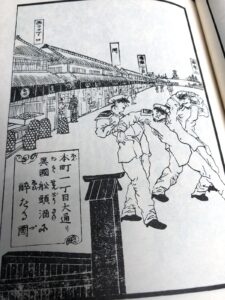
画像出典元 バーテンダーCATMANのブログより「横浜開港見聞誌 」酩酊する水夫を描いた図
It depicts a person who thinks of Macaulay yelling at guests.
Judging from this caricature, it can be seen that the Yokohama settlement at that time was a considerable disorderly place.
Around this time, yokohama citizens did not have a good image of foreigners, and there are records that the ship that called at the port set sail before one is aware and the sailor who was left behind became homeless, or was drunk by alcohol on the roadside and received complaints that were annoying to the neighborhood.
Around 1862, commercial facilities such as various hotels and town taverns opened one after another, and many western liquors were imported to foreigners accordingly.
Whisky, Old Bourbon, Irish and Scotch called “Wheat Sheaf” were imported, you can see in the japan herald advertisement column in 1864.
In addition, several kinds of gin including Geneva and “Old Tom” , “Chartreuse” , Maraschino, Curacao and mint liqueurs were imported.

Image source: Whisky Magazine 1964 Japan Herald ad
1-4 Ei ichibankan
The Jardine Matheson Shokai, which was mentioned in Chapter 2 of Perry’s arrival, opened the port and opened its doors as soon as possible, and the Yokohama branch was established in Yamashita-cho 1 (former Yamashita-cho Settlement No. 1, Naka-ku, Yokohama City, Kanagawa Prefecture), and it was popular from locals under the name “Ei ichibankan” from that number.
This Yokohama branch is the first foreign-affiliated company to expand into Japan.
It was probably handled by our own Scotch, “Old Vated Glenlivet” .
This Yokohama branch was also burned down by the tonya fire, but currently there is a facility called “Silk Center” at the port of Yokohama for the purpose of promoting raw silk, silk industry and trade and developing tourism business, and at the entrance there is a monument that is said to have been the First Building in the UK.
As an aside, “William Kezik (the older sister of William Jardine, founder of the company)” who established the “Jardine Matheson Shokai Yokohama Branch”, later supported five people studying in The United Kingdom called “Choshu Five” and other names such as “Hirobumi Ito”.
1-5 Mysterious Cat Seal whisky
-300x142.jpg)
出典元 ウイスキーマガジン 明治30年4月の逸見山陽堂発行の相場表
The oldest record in which the trade name of whisky clearly appears in the existing materials was 1871, four years after the reversion of the Imperial Government was established and the era name changed in the Meiji era.
It is said that Carnot Shokai in Yokohama imported “Irish whisky Cat Seal” .
The market price list issued by Itumi Sanyodo on the right is from 1905, but it is said that it is “Irish whisky cat seal” and “Deer brand whisky Roman blend” .
Deer symbol marks are often used for Scotch whisky labels, but unfortunately there is no material that can conclude that Shikain Whisky Roman Le Blend is Scotch.
So what kind of product was the Irish whisky cat seal?
Mamoru Tsuchiya of the Whisky Culture Institute and Kazuo Ishikura of Whisky Magazine express their views on whether burke’s “BURKE’S Fine old Irish whisky” was.
From this point of view, Patent Translator Asako Mizuno has written a very interesting blog using the world’s patent database, so I would like to introduce it.
There is an overseas site called “Meiji-Portraits” that covers trading companies that were active in Japan in the Meiji era, which Mr. Mizuno discovered in the process of unraveling from the viewpoint of patents.
Among them, it comes out to search with whisky,

画像出典元 特許翻訳AtoZ
Notation of “J. Curnow & Co.” .
It is likely to be Carnot Company.
Surprisingly, “Carnot Company” also handled glenlivets handled by “Jardine Matheson Company” .
You can also see the notation “Robert Brown’s “Four Crown” Whisky” .
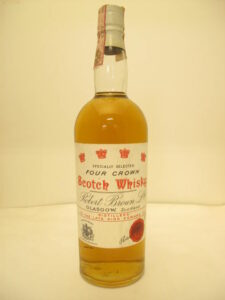
Source whisky paradise Robert Brown’s Scotch Whisky
Founded in 1865, Robert Brown, from Glasgow, made his livelihood in the whisky blend and export trade, and his whisky is on an overseas site featuring an Old Glasgow Pubs Glasgow pub, which describes that queen Victoria also drank it at the time.
However, the data in Meiji-Portraits does not find a notation by Carnot Corporation that deals with Barks whisky.
Then, when I say what is the basis for handling the Irish whisky cat mark purchased by Carnot Shokai, there is a document that summarizes the annual name, items, importer name, and container shape in the Japanese Japanese-Western Sake Can-Tsume Newspaper “History of The History of Dai Nippon Liquor Cansome” published in 1915.
On page 294, “If you mention the name of imported liquor dealers in the first year of the Meiji era” , the reason is that the item of 1879 is “Nekoin Ujo Ski Carnot Shokai Shoulder Tension Round Shape” .
1-6 Whisky presented to the Emperor
When foreign cultures began to flow in after the port opened, and the opportunities to see whisky began to increase, were the politicians of time drinking whisky? By the way, there is no record that the Emperor drank the whisky that Perry said to have presented.
Officially, scotch whisky is said to have been brought back and presented to the Emperor by a “mission”.
As many of you know, I would like to approach the first japanese person who brought whisky to Japan.
2. Tomomi Iwakura, the Ten Greats of the Restoration
He was born in Kyoto as the second son of Yasuchika Horikawa. Mother is Yoshiko, the daughter of Tsunehaya Kajuzi.
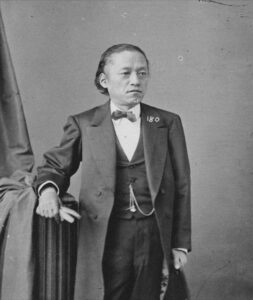
image source: Wikipedia
The childhood name was crowded, but it was called Iwakichi among the children of the school nobles because there was no nobleness in appearance and speech and behavior and it was conspicuous.
He later became an apprentice to Nobuharu Fushihara, a Confucian scholar who served in the imperial court.
Fushihara saw Through Iwakura as a “large person” and recommended adoption to the Iwakura family.
Later, on August 8, 1838, at the age of 13, he was adopted by the Iwakura family and was selected by Fushihara as Tomomi, and was allowed to ascend on October 28 and December 11.
The following year, he served at the imperial court and received 100 bales of government fees.
The Iwakura family had a family of the Urin family, but it was a house with a short history, so the rank and government office to which the owner was ordained were not high.
In addition, it is said that it was not wealthy at all because there was no family business which was transmitted from generation to generation.
2-1 Glory and Fall
In January 1853, iwakura, who was a lower-class court noble, made remarks to the leaders of the Imperial Court, and at the age of 29 he became a samurai follower of Emperor Komei.
Iwakura, who demonstrated excellent political power in the imperial court, realized the marriage of Kazunomiya and Iemochi Tokugawa as a public interest group based on the idea of having a relationship between the imperial court and the shogunate, which had been becoming a rough relationship since the Great Prison of Ansei.
But is this action partly in the Sakuha school? The voice of doubt begins to come out, the doubt calls the doubt, and it is ordered chikkyo, the resignation, and the priest eventually.
Iwakura Gimi resigned in the middle of his mind and left the priest and the Imperial Court.
It was Iwakura Tomi who had become a disposition, but the voice that the disposal was still sweet was raised from the Sou Wang Shii faction, and even received a threatening notice strongly requesting the move out of Kyoto.
Iwakura Gimi, who felt the danger of himself, was unable to continue living in the residence, and hides himself in Reigenji Temple in Nishigamo in the form of a monk.
In addition, Iwakura Tomi who moved to Saiho-ji Temple in Rakusai where the adopted father’s nephew was a chief priest and this Tsuedahiro of the lord put out the exile order to Iwakura Tomi , saying that “It is not necessary to live in Rakuchu” so as to put the tailing strike.
It was the eldest son’s Iwakura Tomotsuna (Iwakura Tomotsuna) to have extended the hand of the rescue to The Iwakura Tomi who embarrassed the place where it lived without going.
He prepared a residence in Iwakura Village in Rakuhoku (coincidentally the name of the village), so he lived there for five years.
In 1864, the 1864 barrier was changed and kyoto’s Sonnojoi ( Revere the Emperor and expel the barbarians) However, there was a person who visited Iwakura there.
2-2 Returning Political Customers
The people who came to see Tomomi Iwakura were Toshimichi Okubo and Shintaro Nakaoka.
As I met with them, I began to conduct activities such as sending political opinions to the imperial court and comrades of the Satsuma domain.
Tomomi Iwakura left this situation in his diary, and it is also recorded that Ryoma Sakamoto came.
By this time, Iwakura Tommoi changed his mind from the Kobu Coalescence faction to the Abugun school.
Emperor Komei died in 1867, and emperor Meiji’s accession to the throne finally lifted the long-standing disposition of residence.
Immediately in the imperial court, executed the grand order of the restoration of the monarchy in 1868, declared the establishment of a new government, the birth of the Meiji government, at the same time excluded Yoshinobu Tokugawa’s entry into the new system, Iwakura will be involved in state affairs again.
After that, the government organization was rebuilt, and it shifted to a three-power separate government referring to the American political system, and edo after the Ueno War, one of Japan’s largest civil wars, was established and renamed Tokyo.
July 1871 Declared the prefecture of the abandoned domain.
On this day, all the feudal lords who lost all the feudal clans from Japan were summoned to Tokyo and fulfilled their responsibilities as royalty.
Japan started as a unified nation under one nation, one head of state.
On the same day, Tomomi Iwakura assumed the post of Minister of Foreign Affairs (now the secretary of the Ministry of Foreign Affairs).
Iwakura, who became a foreign minister, once had the challenge of “amending” the “Treaty of Amity and Commerce between Japan and the United States” and the Unequal Treaty.
Japan, which has not yet complied with the current international law “Universal Public Law” has embarked on a plan to go around the world, enlighten Japan, and then negotiate the revision of the unequal treaty in order to avoid forcing the United States to extend the unequal treaty.
2-3 Whisky of a man who died at the age of 152
Iwakura himself is the first ambassador extraordinary and plenipotentiary, accompanied by Takayoshi Kido, Toshimichi Okubo, Daisuke Kobe, Hirobumi Ito, etc. as vice-envoys.
He formed the Iwakura Mission, and in November 1871 he left yokohama port, traveled to Western countries for 1 year and 10 months, met with heads of state, and handed over the national books, but it seems that he did not get much results.
During this trip, Iwakura brought back the Blended Scotch “Old Par” and presented it to the Emperor.
The bottle of old par has a shape that does not fall even if tilted, and it was said that it was “right shoulder raised” and auspicious.
 Therefore, there are many people who drink well in the political world, such as Shigeru Yoshida and Kakuei Tanaka.
Therefore, there are many people who drink well in the political world, such as Shigeru Yoshida and Kakuei Tanaka.
By the way, this old par label is based on the one written by the master Rubens of the Baroque period, and the name of this old man is “Thomas Parr”
A real person who lived to be 152 years old.
Born in England in 1483
He married for the first time at the age of 80, set up one son and one daughter, but died at an early age, had an affair with the village’s most beautiful woman at the age of 105, and his wife Jane died at the age of 112, but at the age of 122, Rubens and Van, who heard the legend after the legend of no time for remarriage and enumerating, also captured him in the painting.
The famous man was offered to have an audience with the king who roared to the King of England, and even though he went to London and moved to London, he passed away immediately.
The cause of death is what overeating.
It seems that the glittering life in London has accelerated the death.
He still sleeps at Westminster Abbey, where british kings and Isaac Newton are buried.
2-4 Net Truths
These “theories that Iwakura Tomi brought back the old par” are circulated as a common theory on the net, but the place where I inquired to the “Iwakura Gutami Yui old house” management office familiar with Iwakura Tomi
It is a story that Tomi Iwakura brought back the old par and presented it to Emperor Meiji, but as we know in this facility, I have not seen the material which becomes the basis only by information on the Internet yet. If you have a little time, I would like to see as much as I can find here and reply.
We apologize for the inconvenience, but could you give us some time?
Hurry up and reply.
And, the answer of the shock very.
I would like to follow you as soon as we know the new details.
*Added on February 25
Thank you for taking care of me.
We would like to inform you of the results of our previous inquiries, the relationship between Iwakura Tomi and Old Par, which took a long time to confirm.
I confirmed the official record “Special Plenipotentiary Ambassador U.S. and Europe Circular Real Record” when Iwakura traveled abroad, but there was no description of the whisky factory though the record which went to the Highlands in Scotland came out.
In addition, we confirmed the historical materials called “Ambassador’s Report” of the former historical materials of the above materials, but there was a record of going to the Highlands here, but there was no record of visiting a whisky factory etc.
Finally, I also looked at the memoirs of the mission era of Kunitake Kume, the author of the official record, but there was no description that corresponded to this, and I also confirmed The Letter of Tomi Iwakura, but I did not find a record about old par there.
As mentioned above, I tried to hit the material that was likely to appear, but I did not find any such description.
Unfortunately, we were unable to find a description that would meet your expectations this time, but we will continue to confirm it in the future.
We look forward to your continued relationships in the future.
It was very late, but until the answer of the inquiry.
February 25 Senior Curator, Iwakura Gutmi Yui Former Housing Management Office
I came to a conclusion that said
I also contacted Diageo, which handles old par.
Thank you for contacting the MHD website.
There is still a story of bringing back whisky made by the greenlease brothers of the founder, but the release of the Old Par, which remains on diageo’s record, was in 1909 (after the death of Tomi Iwakura).
Therefore, there is no information such as materials and documents related to Iwakura Tomi, so we do not communicate as a brand.Thank you very much.
It was a thing.
The more you dig deep, the more romantic you are.
Iwakura, who returned from a trip from europe and the United States, worked hard to protect Japan from overseas, and ended his life on July 20, 1883 ( Meiji 16 ) at the age of 59 before the enactment of the Constitution of the Empire of Japan, which is the basis of the current constitution.
Tomi Iwakura, who had pharyngeal cancer, was the first person in Japan to receive a cancer notice, and it was the first person in Japan to hold a national funeral, and it was also a portrait of a 500-yen bill that was manufactured until 1985.
– History of Whisky in Japan –
https://en.jpwhisky.net/history-2/whiskeyhistory1-2/
https://en.jpwhisky.net/history-2/history-whiskeyhistory2-2/
https://en.jpwhisky.net/history-2/history-whiskeyhistory3-2/
[box type=”note” align=”” class=”” width=””]
Chapter 4: Shinjiro Torii
Recently released[/box]
[box type=”note” align=”” class=”” width=””]
Chapter 5: Kiichiro Iwai
Recently released[/box]
[box type=”note” align=”” class=”” width=””]
Chapter 6: Masataka Takesuru
Recently published[/box]
[box type=”note” align=”” class=”” width=””]
Chapter 7: Before and after the battle
Recently published[/box]
[box type=”note” align=”” class=”” width=””]
Chapter 8: High growth period – Now
Recently published[/box]

